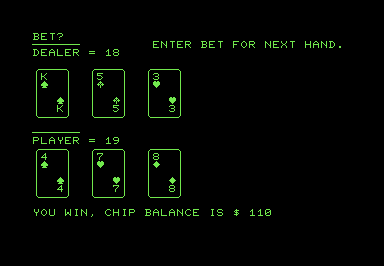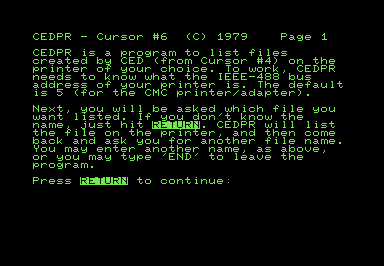CURSOR #6 – January 1979
“Consider this excerpt from a letter: ‘I belong to the Mid-Peninsula
PET Users Group...Your magazine was discussed at the last meeting and it was unanimously decided that
no portion of it would be allowed in our library for the purpose of copying as we know that this would
hamper your circulation. The purpose of our users group is the free exchange of software, but we would
not wish to undermine a fine publication such as yours.’”
—Excerpted from Software Realities, Issue #6

COVER
Author: Jim Hinds
Original file name: COVER
PRG file: cover06.prg
This cover program appears to have been inspired by the cover of CURSOR #3, with a few differences. The line does not "walk" about the screen at random, but rather follows a programmed path. When the line intersects itself, it draws a cross character at the point of intersection. At predetermined intervals, the PETSCII line switches between regular and inverse video. If you leave the animation running for a while, you can clearly see the pattern that emerges from multiple iterations.
Pressing SPACE takes you to the
table of contents for the issue.

BOX
Author: Howard Arrington
Original file name: BOX
PRG file: box.prg
BOX is an implementation of the
Black Box puzzle game,
in which you probe the eponymous black box by sending beams of light into the sides of a grid.
These beams can be absorbed, reflected, or pass through the box either in a straight line or after
a number of deflections. From the behaviour of the beams, you must deduce the location of several
atoms hidden inside the box.
The interface is clean, and the gameplay is quick. You can choose the number of atoms in the
box; the default of five atoms is a reasonable challenge for beginners. My only gripe with this
version is that there's very little hoopla (or messaging of any kind!) when you win. I was waiting
for something to happen when I solved the puzzle, but all you get is a HOW MANY ATOMS?
prompt which is actually an invitation to play another game.

BJACK
Author: John Melissa
Original file name: BJACK
PRG file: bjack.prg
The PETSCII graphics set includes glyphs for the standard card suit symbols (hearts, spades,
diamonds, and clubs), allowing programmers to draw recognizable playing cards with simple
PRINT statements. BASIC card games were common on the PET and CBM computers.
BJACK is a simple game of blackjack that pits the human player against a
computer dealer. The dealer plays in a conventional way and you should be able to come out on
top if you play patiently. There's no shuffle, but there is a subroutine at line 1000 that
flags drawn cards, so you may even be able to get away with card counting. The PET won't
be able to notify security if you try.

PACK
Author: Glen Fisher
Original file name: PACK
PRG file: pack.prg
PACK is a programming utility that strips whitespace out of a BASIC program listing.
For example, if your program has the line:
10 GET K$:IF K$="" THEN 10
then PACK will compress it to:
10 GETK$:IFK$=""THEN10
saving four bytes of RAM.
The compressed version is less readable, but when you only have 8Kb to hold all your program logic and any variables—they need RAM too!—readability is a luxury you can't afford. You want to save every byte you can.

LIST
Author: Glen Fisher
Original file name: LIST
PRG file: list.prg
LIST is a formatter for BASIC program listings to improve program readability. By default, the output is directed to the screen,
but you can change the program to output to a printer. The output of this program is read only; you can read the nicely-formatted listing
while the original BASIC program remains undisturbed in RAM.
LIST program will insert spaces into the output,
right-align line numbers,
and replace control codes
with readable equivalents.

CEDPR
Author: Uncredited
Original file name: CEDPR
PRG file: cedpr.prg
CEDPR is a utility program to print out screens created with the text editor
CED, published in
CURSOR #4.
There are some challenges in getting CED running in the first place: the program will only
run on an "original ROM" PET 2001, and it requires a datasette. CEDPR also requires a
printer, further complicating the setup. Getting printer configurations and interfaces set up correctly
was a challenge in the early days of computing (and, arguably, remained a challenge even into the 1990s).
CEDPR is only useful if you have already created a file with CED, and that
file will have to have been saved
to a datasette before it can be loaded and printed.
